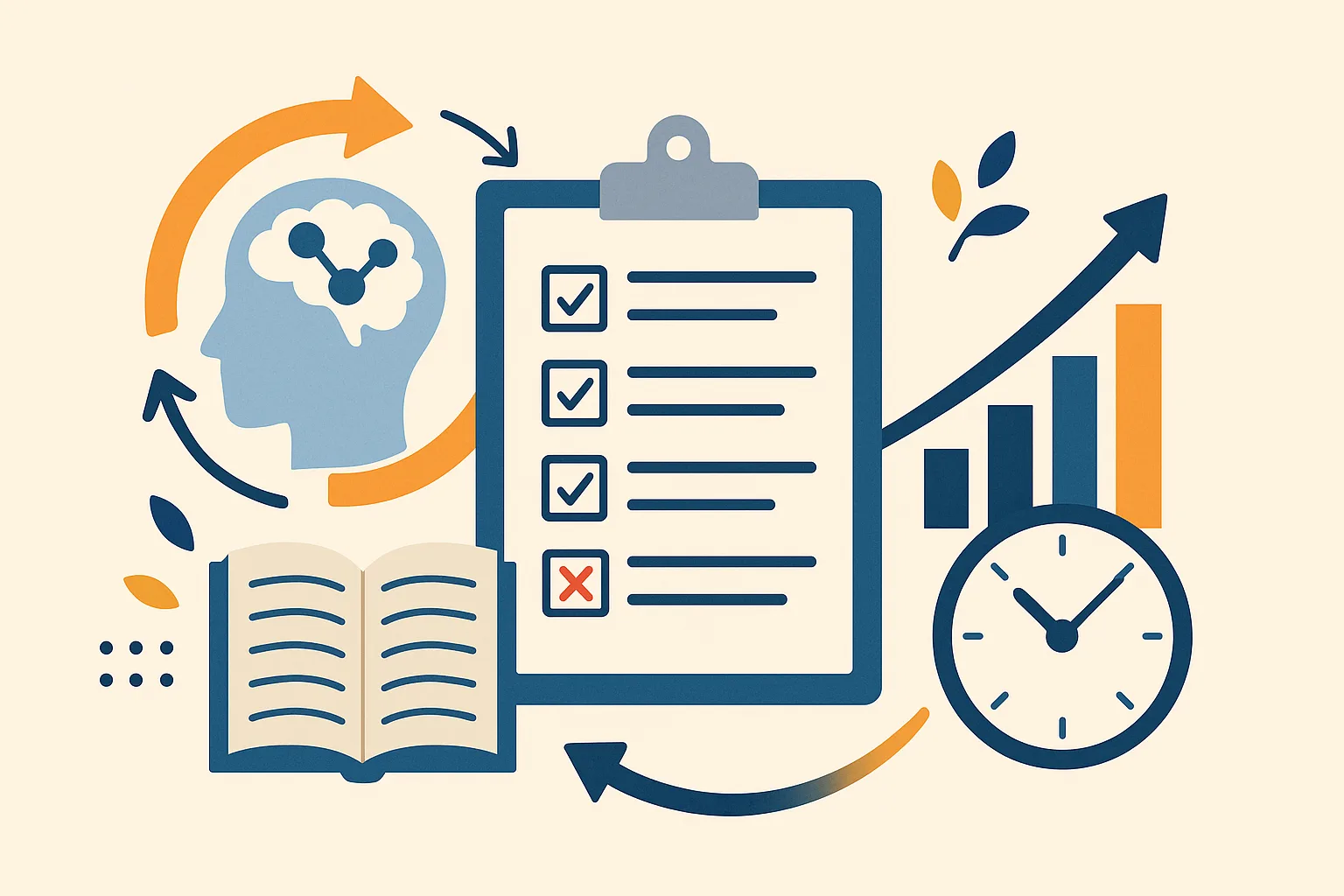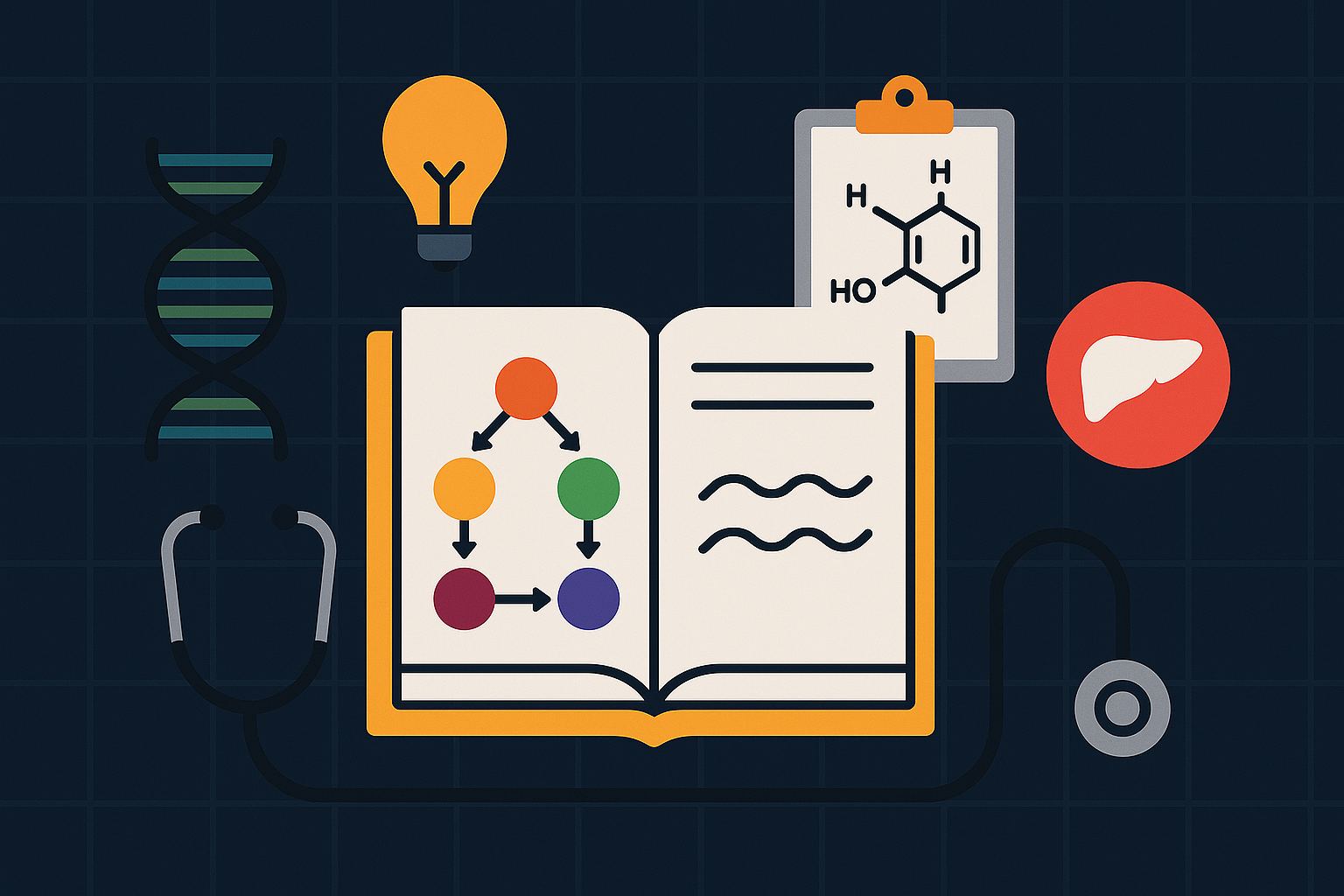Your last attempt contains the blueprint for this one. Begin Day 1 with a two-hour forensic audit: reconstruct test conditions (sleep, nutrition, timing), list system-level weak areas (e.g., renal phys, endocrine pharm), and identify error archetypes (knowledge gap, misread stem, slow calculation, distractor trap, second-guessing). If you have a performance profile from practice exams, map every weak domain to 1–3 concrete knowledge statements you must be able to recall—e.g., “alpha-1 stimulation → ↑IP3/DAG via Gq” rather than “adrenergic stuff.” This precision matters because Step 1 vignettes reward targeted recall under time pressure, not vague familiarity. Build a Misses Ledger in a spreadsheet or notebook with five columns: Topic, Exact Fact/Process, Error Type, Mnemonic/Mechanism Anchor, Follow-up Question IDs. Populate it with 60–100 items across the first three days as you review prior blocks and fresh questions. Every new miss gets an immediate retrieval card (short, single target) and a calendar slot for spaced review. This ledger becomes your daily “to close” list—if it’s not in the ledger, it’s not a controlled fix. Next, define “surgical” scope. A 30-day retake plan cannot re-teach all of pre-clinical medicine. Instead, select ~10–12 content clusters with the best score upside: high-yield physiology mechanisms (autonomics, renal handling, acid–base), path-hallmark pairings (caseating granulomas⇔TB, café-au-lait⇔NF1), and error-prone pharm triads (MOA–Toxicity–Antidote). Commit to closing each cluster with three actions: (1) 20–30 targeted questions, (2) 15-minute mechanism explainer you can reproduce without notes, (3) two-day spaced retrieval touch-ups. Finally, pre-write your test-day antidotes for common failure modes: a misread stem protocol (finger under line + paraphrase aloud), a time crisis protocol (skip after 40 seconds without path), and a second-guessing rule (only change answers for new information, not new anxiety). Put these rules on an index card you’ll rehearse weekly. The audit ends when you have a prioritized hit list, not when you feel “caught up.” Your month is divided into four distinct arcs, each with a clear outcome. Week 1 (Stabilize & Diagnose): establish daily rhythm, rebuild fundamentals in 3–4 weak systems, and log 400–500 targeted Qs with meticulous reviews. Week 2 (Consolidate & Interleave): maintain question volume, begin interleaving systems (renal + cardio + endocrine in one block), and produce short mechanism summaries for each cluster. Week 3 (Pressure-Test): add full-length practice + mixed blocks under timed conditions to stress-test recall. Week 4 (Taper & Sharpen): reduce volume slightly to preserve cognition, focus on error archetypes, and rehearse exam-day routines. Use the schedule matrix below to anchor the right dose of questions, review, and spaced recall. Adjust hours up or down based on your bandwidth, but preserve the ratio: about 50–60% Qbank, 25–35% review/notes-to-cards, 10–15% assessment and logistics. Protect one “light” evening per week to preserve motivation. If you miss a target day, don’t push everything forward; triage: keep the question blocks, compress the note-writing, and maintain spaced reviews. The compounding effect comes from consistent retrieval, not perfect coverage. Every day follows a repeatable cadence: Prime → Perform → Process → Protect. Prime (15–20 min): warm up with 10 rapid-fire recall prompts from yesterday’s ledger. Perform (2–3 hours): complete 2 timed mixed blocks (20–40 Qs each) with strict pacing (average ~84–90 seconds/question). Process (90–120 min): high-fidelity review—classify each miss, write a 1–2 line mechanism or rule, and convert to an ultra-compact card. Protect (30–45 min): spaced retrieval of your tightest deck and a brief walk or nap to consolidate. Structure your clock with energy-aware intervals: 50-minute focus windows followed by 10-minute resets. Use movement, hydration, or a brief breathing drill during resets—no scrolling. If attention drops, switch modalities (draw a pathway, say the mechanism aloud, sketch a decision tree) before you switch tasks. End of day, perform a 5-minute “tomorrow setup”: pick the two clusters you’ll close and pre-load question blocks to match. For retakers, review quality beats question quantity. A single block reviewed deeply can yield more durable points than two rushed blocks. During review, force retrieval: cover the explanation, state the answer plus why each distractor is wrong, and rehearse the 1–2 sentence mechanism. Tag “fast wins” (facts you’ll memorize verbatim) vs “slow burns” (mechanisms you’ll re-explain). Fast wins get micro-cards; slow burns get a hand-drawn mini-schematic you can reproduce without notes. Sleep is part of the plan, not a luxury. You are rebuilding recall pathways; shortchanging sleep taxes hippocampal consolidation and sabotages test-day cognition. Guard a consistent bedtime and a hard stop for screens. When in doubt, trade 30 minutes of passive reading for 30 minutes of sleep and 10 minutes of targeted retrieval tomorrow. Practice exactly how you’ll be tested—adaptive QBank, live CCS, and clarity from your data. Questions are your primary training stimulus. Use MDSteps Adaptive QBank (9,000+ items) to push mixed, exam-like blocks that target your weak domains without siloing. Select mixed, timed, unused as the default. Add a second daily block of missed + marked every other day to recycle hard items under time pressure. During Week 1–2, favor 20–30 item blocks; during Week 3–4, scale to 40-item blocks to rehearse stamina and hydration/timing protocols. In review, prioritize why the correct answer is correct and why each distractor fails (wrong system, wrong time course, wrong mechanism). Write a single “transfer rule” for the vignette (e.g., “Non-anion gap acidosis with hyperkalemia → consider Type IV RTA, low aldosterone”) and add one “anti-confuser” (what would make you not choose this next time). Every rule goes into your Misses Ledger with a short retrieval card. Lean on MDSteps’ integrated features: the automatic study-plan generator converts your performance into a daily to-do, and the AI tutor helps you unpack stems without spoon-feeding answers. Most importantly, enable automatic flashcard decks from misses and export them to Anki—this turns every error into multiple future retrievals. Use the readiness dashboard to trend accuracy by system and task type (mechanism, association, calculation), and re-weight your schedule accordingly. Common pitfalls to avoid: (1) studying only comfortable systems; (2) untimed, tutor-mode question grazing; (3) shallow reviews that copy explanations verbatim; (4) skipping spaced retrieval because “I just read it.” Your comeback depends less on total question count than on how aggressively you convert each miss into a rehearsed, recallable rule. Retakers don’t need more pages—they need more pulls on memory. Three levers dominate: retrieval practice (test yourself before re-reading), spaced repetition (short refreshers at expanding intervals), and interleaving (mixing topics to sharpen discrimination). Operationalize them with ruthless simplicity. For each ledger item, create a single-target card—question on one side, answer plus a seven-to-ten-word mechanism on the other. Keep most cards atomic: one fact, one mechanism, one exception. Use a 1–2–4–7 day spacing ladder for fresh cards during Weeks 1–2, then stretch to 10–14 days for durable items. Interleave across systems inside your daily Qbank blocks and your reviews: pair acid–base with respiratory phys, or renal pharm with endocrine mechanisms. This breaks the illusion of competence that grows from blocked practice and better matches the unpredictability of Step 1 blocks. When a concept is sticky, do a quick generation effect drill: attempt to produce the pathway or table from scratch (without notes), then check against a concise reference. The struggle is the learning—provided the feedback is prompt. If you keep missing the same mechanism, design a discrimination drill: write down two look-alike diagnoses, list three splitters (time course, lab, lesion location), and drill them side by side until you can separate them under a 20-second limit. Keep the deck lean. Delete or merge any card that you can answer instantly three times in a row. Overbuilt decks become chores; lean decks become weapons. Your goal is reliable pull, not encyclopedic coverage. Schedule assessments as training, not as verdicts. In Week 2, run a half-length timed mock (4 blocks) and capture three metrics: block-to-block decay (stamina), time to last 10 questions (pacing), and error type distribution (knowledge vs. process). In Week 3, complete a full-length practice (7 blocks) to rehearse your fueling and break protocol. In Week 4, add 1–2 mini-sims (2 blocks each) to stay sharp without overtaxing recovery. Use the MDSteps readiness dashboard to visualize domain accuracy and volatility. A system that oscillates wildly suggests fragile recall; keep it in daily interleaving. A system that is stably ≥70–75% in mixed blocks often needs only maintenance doses. Inspect time-on-item data: consistent overage on calculation and multi-step mechanism questions signals the need for structured heuristics (set up dimensional analysis before peeking at options; paraphrase stems to 12–15 words max). Translate scores into schedule moves: if endocrine and renal both lag, double their question representation and allocate a short daily mechanism rehearsal (e.g., RAAS cascade aloud). If your accuracy is fine but you’re finishing with seconds to spare, rehearse a disciplined flag/skip loop: after 40 seconds without a path, you must choose between (a) flag + move, or (b) anchor a best guess with a because statement and move. Record a one-page After Action Review (AAR) within an hour of each assessment: What worked? What broke? What will you change tomorrow? Your month improves to the extent your AARs are honest and your adjustments are specific. Confidence follows evidence. In a 30-day sprint, build micro-evidence daily: a finished timed block, a mechanism explained clearly, a ledger item converted to a fast recall. Treat confidence rituals as part of training: a two-minute visualization before blocks (see yourself paraphrase stems, split distractors, and exit with time in the bank), a one-line win at day’s end (“Closed Type II RTA confusion”), and a weekly walk-through of your exam-day routine. Protect recovery windows. Aim for 7–8 hours of sleep plus two short movement breaks outdoors. Use caffeine strategically: early block, not late evening. If anxiety spikes, deploy a 30-second physiological sigh or a 3–5 minute box-breath walk before re-engaging. During Week 3, add a practice day where you eat and hydrate exactly as you will on test day to de-risk GI surprises. Social bandwidth matters. Limit studying with friends to targeted drills; avoid collective venting that inflates stress without producing retrieval. If you have to work while studying, enforce a “non-negotiable core”: one mixed block + one hour of review + 20 minutes of cards—then flex the rest. Momentum beats marathon sessions. Finally, normalize the retake. Many physicians you admire didn’t have linear trajectories. Your job isn’t to be perfect; it’s to design a month where every day extracts a small, bankable improvement. That’s enough to change the outcome. Five to Three Days Out: drop total volume by ~20–30%. Keep one mixed block daily, but shorten reviews. Prioritize ledger high-yielders, pharm tables, and mechanism one-pagers. Walk through your test center plan (route, parking, ID, snacks, layers). Prepare a rapid formulas & ranges card (anion gap, Winters formula, RPF/GFR relationships) and rehearse it twice. Two Days Out: final mini-sim of 2 blocks if energy is good; otherwise focus on light mixed review and cards. Pack your exam kit: IDs, confirmation, comfortable layers, earplugs (if permitted), water, simple carbs, and a salty snack. Lock bedtime; no heroic late-night sessions. Day Before: no new content. 60–90 minutes of retrieval on your tightest deck, plus a full run-through of your timing and break protocol. Move your body, eat predictably, and set alarms. Visualize your first two blocks: you’ll paraphrase stems, answer confidently, skip decisively, and avoid rabbit holes. Exam Morning: light breakfast, 10-minute warm-up cards, full logistics buffer, and your first-block mantra. You’re not aiming for a perfect block—you’re aiming for a disciplined one. If you hit a wall, deploy your misread/time crisis protocols and keep moving. Trust the training. Use this template to launch immediately. Adjust hours to your life constraints, but preserve the structure and ratios. Throughout the month, let MDSteps do the heavy lifting: the adaptive QBank keeps pressure where you need it most, the automatic study-plan generator turns analytics into a daily agenda, the AI tutor helps you interrogate stems like an item writer, and auto-missed-to-anki flashcards ensure every error gets spaced reviews. Track progress on the readiness dashboard to calibrate, not catastrophize.Start With A Forensic Audit: Why You Missed, What You’ll Fix
The 30-Day Architecture: Weekly Milestones That Compound
Week Primary Goal Daily QBank Dose Review & Recall Assessment Deliverables 1 Stabilize, diagnose gaps 60–80 mixed/timed 90–120 min error logs & cards Baseline 2-block mini-sim Misses Ledger v1; 3–4 mechanism one-pagers 2 Close clusters; interleave 80–100 mixed/timed 120–150 min spaced reviews Half-length mock (4 blocks) Cluster checkouts; timing protocol draft 3 Pressure-test timing & stamina 80–100 mixed/timed 90–120 min targeted re-drills Full-length mock (7 blocks) Refined antidote scripts; guess rules 4 Taper, sharpen, rehearse 60–80 mixed/timed 60–90 min high-yield cards 1–2 mini-sims + readiness check Exam-week runbook; logistics checklist Daily Rhythm That Works: Timed Blocks, Deep Review, Planned Recovery
Master your USMLE prep with MDSteps.
100+ new students last month.
Master the QBank: How to Turn Questions Into Score Movement
Memory Levers That Matter: Retrieval, Spacing, Interleaving
Assessment & Feedback Loop: Know When You’re Ready
Mindset & Burnout Control: Rebuild Confidence Like a Skill
Exam Week & Exam Day: Taper, Rehearse, Execute
Rapid-Review Checklist (Print This)
Your 30-Day Day-by-Day (Template) & How to Customize It
Days 1–7 (Stabilize)
Days 8–14 (Consolidate)
Days 15–21 (Pressure-Test)
Days 22–30 (Taper & Sharpen)
Study Schedules for Step 1 Retakers: 30-Day Comeback Plan






